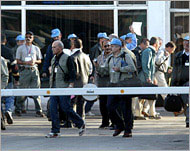Egypt helped Iraq with gas, CIA says
Egypt secretly supplied crucial help – both technology and expert manpower – to the chemical weapons programme of Saddam Hussein’s Iraq in the 1980s, US arms investigators say.

The CIA’s Iraq Survey Group says Egyptian specialists helped the Iraqis make technological leaps on poison gas at the height of the Iran-Iraq War, when Baghdad used nerve agents to kill thousands of Iranian soldiers and Iranian and Iraqi civilians.
The US report is the most authoritative and detailed since such collaboration between the Arab nations was first rumoured in the late 1980s.
The Cairo government rejected earlier allegations, and Egypt’s Washington embassy reiterated the denial when asked by the media about the CIA report. But in interviews with The Associated Press, United Nations arms inspectors who scoured Iraq’s files and facilities in the 1990s corroborated the US finding.
Possessing weapons
Like its former enemy Israel, Egypt has long been thought to possess chemical weapons. Experts say there is strong evidence Egyptian warplanes repeatedly used mustard-gas bombs against royalist forces during Cairo’s intervention in the Yemen civil war of the 1960s.
 |
|
UN arms inspectors corroborated |
In 1981, after the outbreak of war with Iran, President Saddam Hussein’s Iraqi government paid Egypt $12 million “in return for assistance with production and storage of chemical weapons agents,” the US weapons hunters say in a little-noticed section of their Comprehensive Report, a 350,000-word document issued last October.
The Iraq Survey Group, led by CIA special adviser Charles Duelfer, had spent 20 months in 2003-2004 searching for evidence of Iraqi weapons of mass destruction, cited by President George Bush as the rationale for invading Iraq two years ago.
The US arms teams discredited Bush’s claims, finding that Iraq had dismantled its advanced weapons programmes under UN inspection in 1991. In the process, the Americans uncovered previously unreported details of the programmes, such as the findings on Egypt and chemical arms.
“During the early years, Egyptian scientists provided consultation, technology and oversight allowing rapid advances and technological leaps in weaponisation,” the Duelfer report says.
From 1983 to 1988, the Iraqis repeatedly used mustard gas, tabun, sarin and possibly other chemical agents against the Iranians. Most notoriously, in 1988, Iraqi aircraft dropped sarin and mustard gas on Iranian-held villages in rebellious Iraqi Kurdistan, killing up to 5000 Iraqi Kurdish civilians.
Report findings
The Duelfer report says that in the mid-1980s Baghdad had invited Egyptian chemical weapons experts to Iraq to help with production of sarin, a nerve agent that when inhaled can produce symptoms within seconds – convulsions, paralysis, respiratory failure and possibly death.
From five tons in 1984, Iraqi sarin production rose to 209 tons in 1987 and 394 tons in 1988, the report says.
The US arms hunters specify two other instances of critical Egyptian help: In 1983, the Egyptians modified the Iraqis’ Grad 122mm multiple-launch rocket system to enable warheads to carry chemical agents. That powerful weapon system can launch 40 rockets with a range of 19.2km.
A year later, the Egyptians supplied Iraq with 2.73m-long Grad rockets pre-equipped with plastic inserts in the warheads to hold the poisons, said the report.